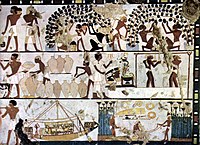Egyptian wine
To overcome these difficulties vineyards in Egypt apply innovative solutions, such as using pergolas to shade the plants and palm trees to shield them from winds as well as transporting the harvest in refrigerated trucks.
[4] Before the construction of the Aswan High Dam the annual flooding of the Nile (Egyptian Arabic: وفاء النيل Wafa' El Nil) provided fertile and hydrated soil for the vines, and the stable weather conditions made it a competitive location for the cultivation of wine grapes.
[5] At the time the state-owned Al Ahram Beverages Company was privatized in 1997 all noble grapes that had previously been planted by its subsidiary, Gianaclis Vineyards, were lost.
This coincided with a boom in the tourism industry which meant wineries had to produce cheap wine in large quantities to meet the surging demand from Western tourists.
[7] Koroum of the Nile, a winery based in El Gouna, cultivates an indigenous grape variety known as Bannati which is used in its Beausoleil white wine.
[10] A thriving royal winemaking industry was established in the Nile Delta following the introduction of grape cultivation from the Levant to Egypt c. 3000 BC.
The industry was most likely the result of trade between Egypt and Canaan during the early Bronze Age, commencing from at least the 27th-century BC Third Dynasty, the beginning of the Old Kingdom period.
Christians constituted the majority of Egypt’s population by the 3rd century, despite a reserved attitude towards alcohol in the Church of Alexandria monasteries are known have stored and produced large quantities of wine.
[17] Viticulture was revived in Egypt by Greek-Egyptian tobacco merchant and entrepreneur, Nestor Gianaclis, who founded the country's first modern vineyard south of Alexandria in 1882.
Its new owner, Egyptian businessman Ahmed Zayat, restructured the company and introduced a line of non-alcoholic beverages that would appeal to the conservative segment of the population.



